Posted: September 25th, 2013 | No Comments »
This week is, importantly, Banned Books Week which celebrates the freedom to read. Banned Books Week was launched in 1982 in American in response to a sudden surge in the number of challenges to books in schools, bookstores and libraries. Scarily books on the list that have been banned after pressure include such society-threatening dangers as Captain Underpants (too rude!), The Kite Runner (gay themes) and (amazingly) Toni Morrison’s Beloved (the book banners holy trinity of sex, violence and religion). You can find out more about banned books here.
However, this blog concerns itself with old China, treaty port China and the lifes and activities of the old foreign community before 1949. So, I’m going to offer a list of books banned by the Shanghai Municipal Police censors in 1940 (the last year they got to ban books before the Japanese invaded the International Settlement). Quite why all these books were banned, seized from Shanghai bookshops and confiscated is a little unclear – sex for sure (more specifically, it’s thought, descriptions of white women having, and enjoying, sex that might have sullied their reputation with the Chinese!) as well as an attempt to force the Settlement’s book stores to ban what was banned in Britain and America (though some of these books were already available after earlier bans in Europe and America).
The following books were noted by undercover cops in Shanghai on sale in Settlement bookstores in the summer of 1940 and seized by
the Shanghai Municipal Council’s Translation Office and the Shanghai Municipal Police in the form of Special Branch (S5)…..
D.H. Lawrence’s Lady Chatterley’s Lover,
Alexander Kuprin’s Yama: the Pit
James Joyce’s Ulysses
Theodoor van der Velde’s Ideal Marriage: Its Physiology and Technique as well as Sex Hostility in Marriage: Its Origin, Prevention and Treatment and Sex Techniques in Marriage
(author unknown) Sex Life in France
Ely Culbertson’s The Strange Lives of One Man, a rather racy, for the time, memoir by a contact bridge player and rampant self-publicist. Theodoor van der Velde’s Sex Hostility in Marriage: Its Origin, Prevention and Treatment and Sex Techniques in Marriage, as well as
Victor Robinson’s Encyclopaedia Sexualis
(Author unknown) The Power to Love.
S5 really hated Lawrence and also seized Women in Love, The Rainbow, The Woman who Rode Away, Aaron’s Rod, The White Peacock, Sons & Lovers, Lovely Lady, The Ladybird and The Lost Girl as well as a collection of Lawrence stories, A Modern Lover.
Personally I’m opting for Yama: The Pit as I’ve never read it – all about prostitutes in Odessa apparently….
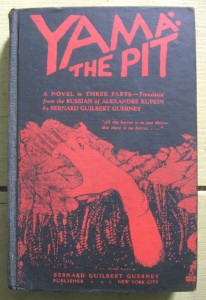
Posted: September 24th, 2013 | No Comments »
ISAMU NOGUCHI AND QI BAISHI: BEIJING 1930 – Organized in conjunction with the University of Michigan Museum of Art, this show explores the relationship between Noguchi and the Chinese ink painter Qi Baishi. It will include Noguchi’s brush-and-ink “Peking Scroll Drawings,†made during a stay in Beijing. Sept. 24-Jan. 26, the Noguchi Museum, (718) 204-7088, noguchi.org. Travels to the Frye Art Museum, Seattle (Feb. 22-May 25).
PS: I’ll be speaking at the exhibition on October 13th about Peking in 1930…more details to follow or here….
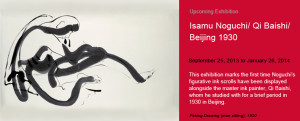
Posted: September 23rd, 2013 | No Comments »
One of my occasional posts on old Chinese restaurants in London. In 1922 the Hungarian composer Bela Bartok was spending some time in London. He attended a part given by the wireless genius Marconi. A few days later he visited a Chinese restaurant in the city – sadly we don’t know which one. Bartok had some rather odd views of Chinese food, as he wrote on a postcard (of Westminster Abbey by the way) to his 11-year-old son (also Bela) in 1922 and quoted in Malcolm Gillies’s Bartok in Britain…
26 March 1922, London
Â
My concert was the day before yesterday. Afterwards, someone took me to have supper – just imagine with whom – the famous Marconi, who was throwing a big party in a hotel. (It was only completely by chance that I dropped in there.) There were all kinds of good things there: oysters, fish, game stuffed with goose liver, champagne, real cognac. But you would have stayed hungry! Still, the day before yesterday I was taken to a Chinese restaurant. Of course I wanted to order dog and cat meat (if it is going to be Chinese, then let it really be Chinese), but there was nothing like that on the menu. But I still ate some rather curious things. Horses have already completely disappeared from the streets here; just once in a while you see one or two harnessed to a carriage. Bye-bye – and kisses,
Â
Your Father
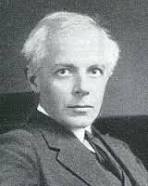
Posted: September 22nd, 2013 | No Comments »
Jeremy Clarke’s The Virgin Mary and Catholic Identities in Chinese History…..
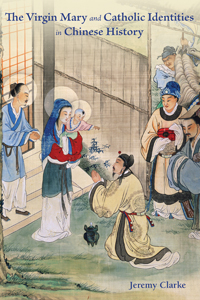
The Chinese Catholic Church traces its living roots back to the late sixteenth century and its historical roots back even further, to the Yuan dynasty. This book explores paintings and sculptures of the Virgin Mary and the communities that produced them over several centuries. It argues for the emergence of distinctly Chinese Catholic identities as artistic representations of the Virgin Mary, at different times and in different places, absorbed and in turn influenced representations of Chinese figures from Guanyin to the Empress Dowager. At other times indigenous styles have been diluted by Western influences—following the influx of European missionaries in the nineteenth century, for example, or with globalization in recent years. The book engages with history, theology and art, and draws on imagery and archival photographs that have been largely neglected. As a study of the social and cultural histories of communities that have survived over many centuries, this book offers a new view of Catholicism in China—one that sees its history as more than simply a cycle of persecution and resistance.
Fr. Jeremy Clarke, SJ, is an Australian Province Jesuit teaching as an assistant professor in the History Department of Boston College. He is also a school visitor in the Australian Center for China in the World at the Australian National University, Canberra.
“In this path-breaking work the author asks, ‘How are Chinese Catholic identities expressed through images?’ In answering this, he skilfully interweaves the different ways in which the Virgin Mary has been depicted in Chinese iconography with the changing circumstances of the local church, China’s tumultuous history, and how this relates to broader ecclesiastical, cultural and international developments. Anyone interested in religion, modern China, or cultural exchange, should read this book.â€
—Richard Rigby, Executive Director of The China Institute, Australian National University
Posted: September 21st, 2013 | No Comments »
Well this is one of those slightly obscure posts because the venue is fictional. I happened to be reading Compton Mackenzie’s 1912 novel Carnival and a rather interesting place, fictional I think sadly, popped up. Carnival is, as one publishers blurb explains:
The moving romance of dancer Jenny Pearl: a story which helped establish Mackenzie among the foremost novelists of his generation. Jenny Pearl, a dancer, falls in love with Maurice Avery, a young dilettante who leaves her when she refuses to become his mistress. Despairingly, she falls into a loveless marriage with Trewhella, a Cornish farmer who becomes insanely jealous when Avery reappears on the scene…Vivid, moving and ultimately tragic, CARNIVAL was first published in 1912 to wide critical acclaim, helping to establish Mackenzie as one of the foremost British novelists of his generation. It has since been filmed three times and adapted for the stage and as an opera.
At one point young Jenny is walking out with Maurice in central London. Maurice decides he needs a cup of decent coffee and, in these wonderfully pre-Starbucks/Costa days, as they’re in Soho Square suggests a coffee shop venue to Jenny (who dances at the wonderfully named Orient Palace of Varieties on Piccadilly*), who’s a bit bemused:
“…where’s this unnatural tea-shop?”
“Just here”
“It Looks like the Exhibition”
It was a dim coffee-shop hung with rugs and gongs. The smoke of many cigarettes and joss-sticks had steeped the gloom with Arabian airs.
“It is in a way a caravanserai,” said Maurice.
“A What?” said Jenny.
“A caravanserai – a Turkish pub, if you like it better.”
“You and I are seeing life today.”
“I like my coffee freshly ground,” Maurice explained.
“Well, I like tea.”
“The tea’s very good here. It’s China.”
“But I think China tea’s terrible. More like burnt water than tea.”
“I’m afraid you don’t appreciate the East,” he said.
“No I don’t if it means China tea.”
“I wish I could take you away with me to Japan. We’d sit under a magnolia and you should have a kiss for every petal that fell.”
“That sounds rather nice.”
*=there was a music hall called the Oriental Palace of Varieties, established by the Dan Leno Company in 1896 but it was south of the river in Camberwell (below).
Posted: September 20th, 2013 | No Comments »
The beautiful Cutty Sark has had its ups and downs – a tea clipper on the India-China run built originally in the 1860s it sat in dry dock at Greenwich until the awful fire in 2007 and is now restored and back on display. Her first round trip voyage under captain George Moodie began 16 February 1870 from London with a cargo of wine, spirits and beer bound for Shanghai. The return journey with 1450 tons of tea from Shanghai began 25 June, arriving 13 October in London via the Cape of Good Hope. Unbelievably fast for the time. More on the ship’s history here.
Now Royal Mail has put Cutty Sark on some stamps celebrating the Merchant Navy…
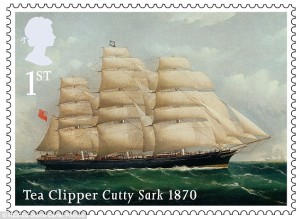
Interestingly this is not the first time the Cutty Sark has been on the stamps as the below shows….


Posted: September 20th, 2013 | No Comments »
A much needed and very useful comprehensive overview of the British army in China from opium to handover….
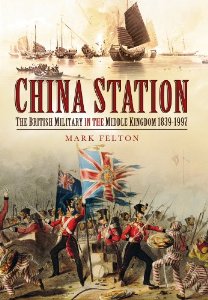
The Author, who lives in Shanghai, sets out to demonstrate that the British military has been at the forefront of many of the great changes that have swept China over the last two centuries. He devotes chapters to the various wars, military adventures and rebellions that regularly punctuated Sino/British relationships since the 1st Opium War 1839-1842. This classic example of Imperial intervention saw the establishment of Hong Kong and Shanghai as key trading centres. The Second Opium War and the Taiping and Boxer Rebellions saw the advancement of British influence despite determined but unsuccessful efforts by the Chinese to loosen the grip of Western domination. The Royal Navy’s might ensured that, by ‘gunboat diplomacy’, trading rights and new posts were established and great fortunes made. But in the 1940s the British grossly underestimated Japanese military might and intentions with disastrous results. After the Second World War the British returned to find that the Americans had supplanted them. The Communists’ victory in the Civil War sealed British and Western fates and, while Hong Kong remained under British control until 1997, the end of British rule was almost inevitable. But the handover was a masterly piece of pragmatic capitalism and the former Colony remains an economic powerhouse with strong British influence.
Posted: September 19th, 2013 | No Comments »
Advance notice for an event I’m speaking at in New York at The Noguchi Museum in Long Island City on 13/10. Delighted to be doing it as a fan of both Isamu Noguchi and his Peking mentor Qi Baishi….more information on the event and the Noguchi Museum here…

Paul French | Peking 1930 – Isamu Noguchi and his Encounter with China’s Cultural Capital and Avant Garde Milieu
Sunday, October 13, 2013 – 3:00pm – 4:00pm
When Isamu Noguchi arrived in Peking for the first time in June 1930 he declared “Peking is like Paris.” In China Noguchi was continuing his journey to being a World Citizen and influential Modernist artist. Previously, in New York, Paris and London, Noguchi had learned to appreciate “the value of the moment,” but also became interested in Asian art forms and styles. As a committed Modernist he explicitly rejected the ideology of Realism and in doing so he sought to make use of the artistic styles of ancient traditions. In China he was to study under Qi Baishi, the classical water colorist, calligrapher and woodcutter.
However, Noguchi’s sojourn in Peking came at a time of intense political upheaval in the former Chinese capital. On the eve of the Japanese annexation of Manchuria, Peking was in thrall to rampant warlordism. It was a city on the edge- both in terms of its proximity to Japanese incursions in the north, and rising fears among the city’s population for their future political stability. Peking was a place of vast contrasts- both ancient and modern, imperial and republican, a centre of classical Chinese culture as well as home to an international expatriate group of aesthetes, Modernists and avant-gardists. While Noguchi’s time with Qi Baishi is the focus of this exhibition, the influence of Peking itself, his exposure to its intellectuals and sojourners from Europe, America and Japan was highly influential on his emergent Modernist outlook and later work.
In this presentation writer and historian Paul French (author of Midnight in Peking and The Badlands: Decadent Playground of Old Peking) seeks to explain Peking in 1930, the city itself, the people who inhabited it and their joint effect on Isamu Noguchi and his work.











